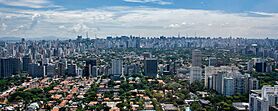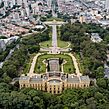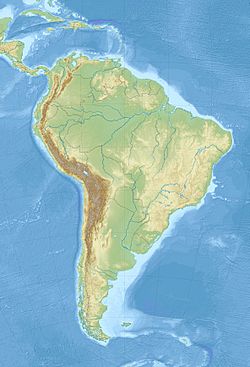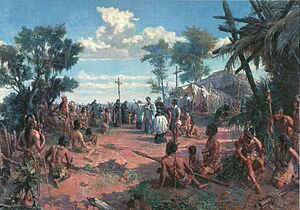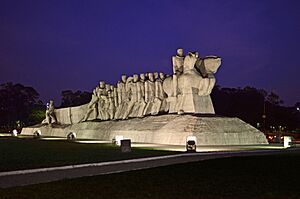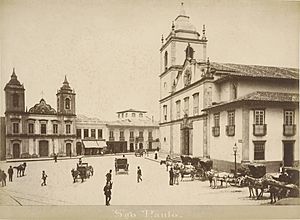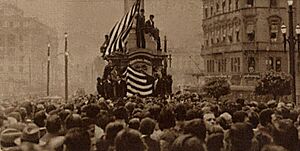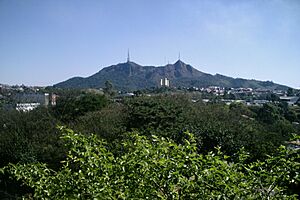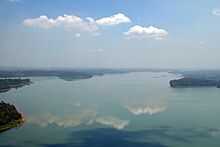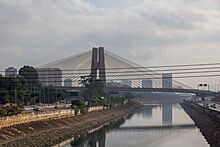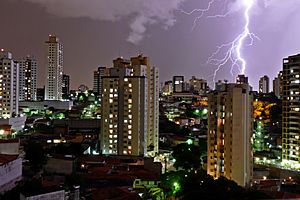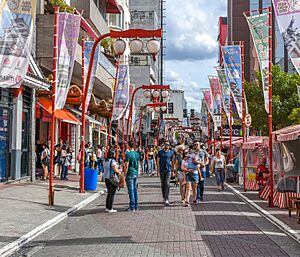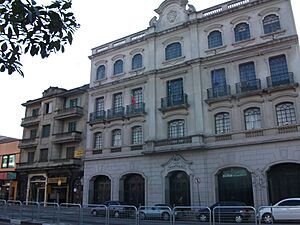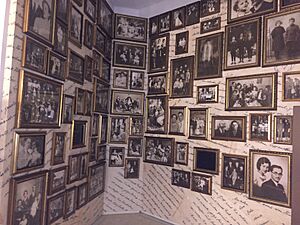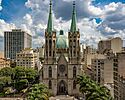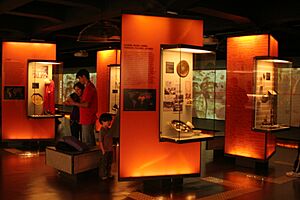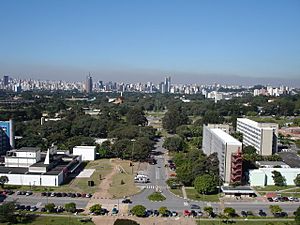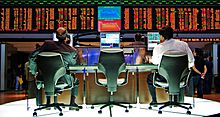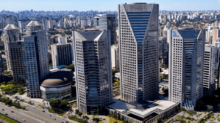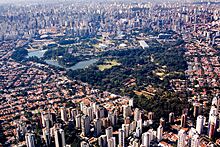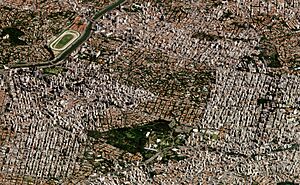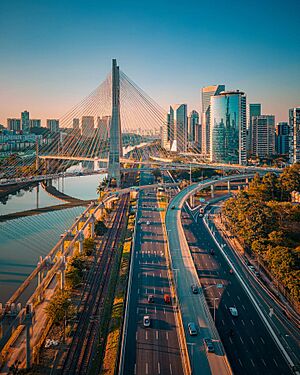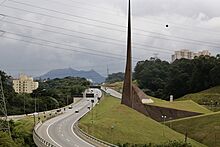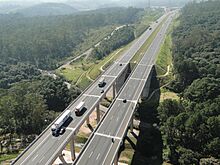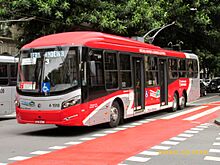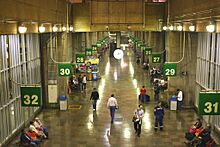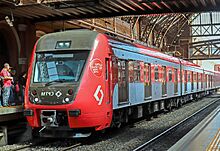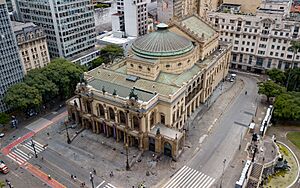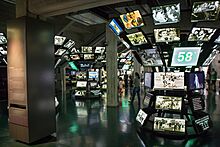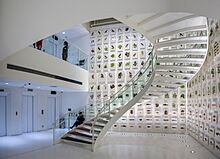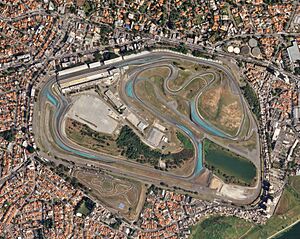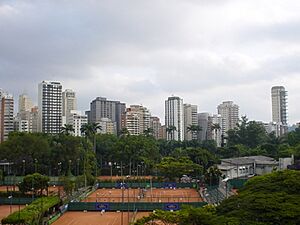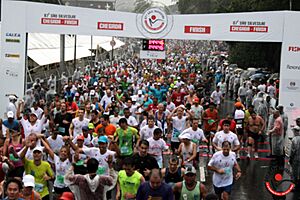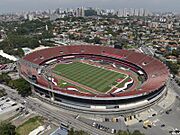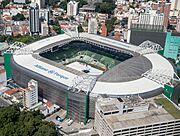São Paulo facts for kids
Quick facts for kids
São Paulo
|
|||
|---|---|---|---|
|
Municipality
|
|||
| Municipality of São Paulo Município de São Paulo |
|||
|
Skyline of São Paulo from Jardins
Obelisk at Ibirapuera Park
Ipiranga Museum at Independence Park
Altino Arantes Building at Downtown
Octávio Frias de Oliveira Bridge and CENU
Municipal Theatre
|
|||
|
|||
| Nickname(s):
Selva de Pedra (Concrete Jungle); Terra da Garoa (Drizzle Land); Sampa; "Pauliceia Desvairada" (Crazy Pauliceia)
|
|||
| Motto(s): | |||
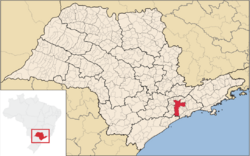
Location in the state of São Paulo
|
|||
| Country | Brazil | ||
| State | São Paulo | ||
| Historic countries | Kingdom of Portugal United Kingdom of Portugal, Brazil and the Algarves Empire of Brazil |
||
| Founded | 25 January 1554 | ||
| Founded by | Manuel da Nóbrega and Joseph of Anchieta | ||
| Named for | Paul the Apostle | ||
| Government | |||
| • Type | Mayor–council | ||
| • Body | Municipal Chamber of São Paulo | ||
| Area | |||
| • Municipality | 1,521.11 km2 (587.3039 sq mi) | ||
| • Urban | 11,698 km2 (4,517 sq mi) | ||
| • Metro | 7,946.96 km2 (3,068.338 sq mi) | ||
| • Macrometropolis | 53,369.61 km2 (20,606.12 sq mi) | ||
| Elevation | 760 m (2,500 ft) | ||
| Population
(2022)
|
|||
| • Municipality | 11,451,999 | ||
| • Rank | 1st in South America 1st in Brazil |
||
| • Density | 8,005.25/km2 (20,733.5/sq mi) | ||
| • Urban | 22,439,956 | ||
| • Metro | 22,807,000 (Greater São Paulo) | ||
| • Metro density | 2,714.45/km2 (7,030.4/sq mi) | ||
| • Macrometropolis (Extended Metro) | 34,500,000 | ||
| Demonym(s) | Paulistan | ||
| GDP (nominal) (metro area) | |||
| • Year | 2023 | ||
| • Total | $319.3 billion | ||
| GDP (PPP, constant 2015 values) (metro area) | |||
| • Year | 2023 | ||
| • Total | $531.3 billion | ||
| Time zone | UTC−03:00 (BRT) | ||
| • Summer (DST) | UTC−02:00 (BRST) | ||
| Postal Code (CEP) |
01000-000
|
||
| Area code(s) | +55 11 | ||
| HDI (2010) | 0.805 – very high | ||
| Primary Airport | São Paulo–Guarulhos International Airport | ||
| Domestic Airports | São Paulo–Congonhas Airport Campo de Marte Airport |
||
| Interstates | |||
| Rapid Transit | São Paulo Metro | ||
| Commuter Rail | CPTM | ||
São Paulo (pronounced sow POW-loh) is the biggest city in Brazil. It is also the capital of the state of São Paulo. This huge city is known around the world for its business, money, art, and fun. It's the largest city outside Asia and the biggest city where Portuguese is spoken. The city is named after Paul the Apostle. People from São Paulo are called paulistanos. The city's motto in Latin is Non ducor, duco, which means "I am not led, I lead."
São Paulo was started in 1554 by Jesuit priests. It grew a lot during the time of coffee farming in the 1800s. Later, in the 1900s, it became a major center for factories. This made São Paulo a very diverse city. It is home to the largest groups of people with Arab, Italian, and Japanese backgrounds in the world. You can find special neighborhoods like Bixiga, Bom Retiro, and Liberdade. People from over 200 other countries live here too.
The area around the city has 20 million people. It is the most populated in Brazil. It is also one of the biggest in the world. When many cities grow together, it forms a "megalopolis." The São Paulo Macrometropolis is the first one in the Southern Hemisphere, with over 30 million people.
São Paulo has the biggest urban economy in Latin America. It makes up about 10% of all the money earned in Brazil. The city is home to B3, the largest stock exchange in Latin America. Many big international companies have their main offices here. São Paulo is also a major center for science. Its main school, the University of São Paulo, is often called the best in Brazil and Latin America. The city has many tall buildings, like the Mirante do Vale and Banespa.
São Paulo is a big cultural center in Latin America. It has many famous places like the Latin American Memorial and Ibirapuera Park. You can visit museums like the São Paulo Museum of Art and the Museum of the Portuguese Language. The city also hosts big events. These include the São Paulo Art Biennial and São Paulo Fashion Week. It also has the São Paulo Gay Pride Parade, which is the second largest LGBT event in the world. São Paulo has hosted major sports events too, like the 1950 and 2014 FIFA World Cups. It also hosts the yearly São Paulo Grand Prix for Formula One racing.
Contents
History of São Paulo
Early Times: Before Europeans Arrived
The area where São Paulo is now was once called Piratininga plains. It was home to Tupi people like the Tupiniquim and Guarani tribes. These tribes lived in different chiefdoms. A famous chief was Tibiriçá, who helped the Portuguese settlers. Many places, rivers, and neighborhoods in São Paulo still have their original Indigenous names. Some examples are Tietê, Ipiranga, and Piratininga.
Colonial Period: How the City Began
The city of São Paulo started on January 25, 1554. Jesuit priests, including Manuel da Nóbrega and José de Anchieta, built a mission here. They wanted to teach Christianity to the Native Indians. The mission was built on a hill between two rivers, the Anhangabaú and Tamanduateí. This spot was good for protection from attacks.
In 1560, more people moved to the area near the college. It was then called "College of St. Paul of the Piratininga." Later, it became known simply as Vila de São Paulo. For about 200 years, São Paulo was a small, quiet village. People mostly grew food to feed themselves. It was hard to travel to São Paulo because of the mountains.
In 1681, São Paulo became the capital of the São Vicente region. This made it a more important place.
The Bandeirantes: Explorers and Pioneers
In the 1600s, São Paulo was one of the poorest places in the Portuguese colony. But it became a center for explorers called bandeirantes. These brave people traveled into new lands. They were looking for gold, diamonds, and other valuable things. They also captured Native Indians to use as slaves.
The bandeirantes became very powerful. They even forced the Jesuits to leave São Paulo in 1640. The Jesuits did not agree with the bandeirantes enslaving Indians. When gold was found in the 1690s, more people came to São Paulo. This helped the Portuguese expand their land in Brazil.
When the gold ran out in the late 1700s, São Paulo started growing sugar cane. This crop was sent to the Port of Santos. A new road was built to the coast, called the Calçada do Lorena. Today, the governor's home in São Paulo is called the Palácio dos Bandeirantes (Bandeirantes Palace).
Imperial Period: Coffee and Growth
Brazil became free from Portugal in 1822. Emperor Pedro I declared São Paulo an Imperial City. In 1827, a law school opened. This brought many students and teachers, helping the city grow.
The growth of coffee farming was a huge reason for São Paulo's success. Coffee became the main crop sold from the region. In 1869, São Paulo was connected to the port of Santos by a railroad. More railroads were built, making São Paulo a central point for coffee transport.
In 1888, slavery was ended in Brazil. This meant coffee farms needed new workers. Many immigrants came to São Paulo, especially from Italy, Japan, and Portugal. They found jobs in the new factories that started to appear.
Old Republic Period: Industry and Modern Art

When Brazil became a republic in 1889, coffee was still very important. São Paulo became powerful in Brazilian politics. It worked with the state of Minas Gerais in what was called "coffee and milk" politics. São Paulo grew from a regional town to a major city. It became industrialized and reached one million people by 1928.
Factories began to appear, making São Paulo a busy, smoky city. Many of these factories were started by immigrant families. The city's art scene also changed. Artists like Mário de Andrade and Tarsila do Amaral started the Modernist movement. The Modern Art Week in 1922 at the Theatro Municipal was a very important event for new art ideas. In 1929, São Paulo got its first skyscraper, the Martinelli Building.
Today, São Paulo's economy is mostly about services, not factories. Old factory buildings are now used for other things. Some nearby cities still have many factories.
In 1924, São Paulo had a big armed conflict called the São Paulo Revolt. It lasted 23 days and caused many deaths and injuries. The government bombed the city, making many people flee. This was the largest urban conflict in Brazil's history.
Modern Era: Growth and Challenges
In 1932, São Paulo had another big movement called the Constitutionalist Revolution. The people fought against the government of Getúlio Vargas. In 1934, the University of São Paulo (USP) was founded. It is now the largest university in Brazil.
During the 1930s and 1940s, more industries came to São Paulo. This growth continued after World War II. In 1947, the Via Anchieta highway was built, connecting the city to the coast. By the 1950s, São Paulo was known as "the city that never stops." It was one of the fastest-growing cities in the world.
In 1954, São Paulo celebrated its 400th birthday. The Ibirapuera Park was opened for this event. The city's financial center moved from the old downtown area to Paulista Avenue. This led to many old mansions being replaced by large buildings.
Leaders like Francisco Prestes Maia and Ademar de Barros helped shape São Paulo. They planned new avenues to improve traffic. They also started the São Paulo Metro system. Construction began in 1968, and the metro opened in 1974. By the early 1960s, São Paulo had four million people.
By the end of the 1900s and early 2000s, São Paulo became the main financial center in South America. It is now one of the most populated cities in the world. São Paulo is seen as an "alpha global city," meaning it has a big influence worldwide. It has one of the largest economies in the world.
Geography of São Paulo
São Paulo is the capital of Brazil's most populated state. It is located at about 23°33' south and 46°38' west. The city covers an area of 1,521.11 square kilometres (587.30 sq mi). Most of this area, about 949,611 square kilometres (366,647 sq mi), is urban.
The city sits on a high plateau, about 799 meters (2,621 ft) above sea level. This plateau is behind the Serra do Mar mountain range. The Atlantic Ocean is only about 70 kilometers (43 mi) away. Two highways, the Anchieta and the Imigrantes, connect São Paulo to the port city of Santos. The city's land is mostly hilly, except in the north where the Serra da Cantareira mountains are. This area still has a large part of the Atlantic Rain Forest. São Paulo does not have many earthquakes.
Rivers and Water in São Paulo
The Tietê River and its smaller river, the Pinheiros River, were once clean. People used them for fresh water and fun. But in the late 1900s, factories and homes polluted them badly. Now, a big project is trying to clean up both rivers. These rivers are not used for boats in the city.
There are no large natural lakes in São Paulo. But the Billings and Guarapiranga reservoirs are used for power and water. People also use them for fun activities like sailing. The original plants in the area were mostly evergreen trees. Many plants from other places also grow here.
The northern part of the city has the Cantareira State Park. This park protects a big part of São Paulo's water supply. In 2015, São Paulo had a major drought. This caused water rationing in many cities.
Green Spaces and Animals
São Paulo is where three different types of natural areas meet. These include forests and savannas. Many native plants used to grow here, like araucaria trees and ipês.
In 2010, São Paulo had 62 city and state parks. The Cantareira State Park is one of the largest urban forests in the world. It covers 7,900 hectares (20,000 acres). Other parks include Ibirapuera Park and Jaraguá State Park. Jaraguá Park is a World Heritage Site recognized by UNESCO.
In 2009, São Paulo had 2,300 hectares (5,700 acres) of green space. This is less than 1.5% of the city's area. The World Health Organization (WHO) suggests 12 square metres (130 sq ft) of green space per person. About 21% of the city's area is covered by green spaces, including nature reserves.
You can see forest birds in the city, especially in spring. Common birds include the rufous-bellied thrush and hummingbird. Even with pollution, the Tietê and Pinheiros rivers have animals like capybaras, hawks, and herons. Other animals found in the city are the howler monkey and green-billed toucan.
Environment and Pollution
Air pollution in some parts of São Paulo is too high. This is mainly because of car traffic. The World Health Organization (WHO) says that 20 micrograms of tiny particles per cubic meter of air is a safe yearly average. In 2011, São Paulo had 38 micrograms per cubic meter. This is higher than the safe limit. A study in 2013 found that air pollution causes more deaths than traffic accidents.
The Tietê River is the most polluted river in Brazil. A project to clean it up started in 1992. Billions of reais were spent, but the project did not fully succeed. In 2019, a new project began to clean up the Pinheiros River, which flows into the Tietê.
Getting enough clean water for the city is also a problem. São Paulo has to get water from far away. Water pollution is made worse by buildings being built in areas that protect water sources. This happens because it's hard for people with low incomes to find affordable housing. Also, many people use cars instead of public transport. This leads to more than one vehicle for every two people, making pollution worse.
Climate and Weather
São Paulo has a humid subtropical climate. This means it has warm, rainy summers. The average low temperature in summer is about 19 °C (66 °F), and the high is around 28 °C (82 °F). Winters are mild, with temperatures usually between 12 and 22 °C (54 and 72 °F). The hottest temperature ever recorded was 37.8 °C (100.0 °F) in 2014. The coldest was −3.2 °C (26.2 °F) in 1918.
The city gets a lot of rain, about 1,454 millimeters (57.2 in) each year. Most of the rain falls in the warmer months. São Paulo has never been hit by a tropical cyclone, and tornadoes are rare. In late winter, especially August, the city sometimes has a "little summer." This is hot and dry weather. But cool days can happen in summer too, when winds blow from the ocean.
São Paulo is facing more droughts and water shortages. This is due to deforestation, water pollution, and climate change.
| Climate data for São Paulo (Mirante de Santana, 1991–2020, extremes 1887–present) | |||||||||||||
|---|---|---|---|---|---|---|---|---|---|---|---|---|---|
| Month | Jan | Feb | Mar | Apr | May | Jun | Jul | Aug | Sep | Oct | Nov | Dec | Year |
| Record high °C (°F) | 37.0 (98.6) |
35.9 (96.6) |
34.3 (93.7) |
33.4 (92.1) |
31.7 (89.1) |
28.8 (83.8) |
30.2 (86.4) |
33.0 (91.4) |
35.7 (96.3) |
37.8 (100.0) |
37.7 (99.9) |
35.6 (96.1) |
37.8 (100.0) |
| Mean daily maximum °C (°F) | 28.6 (83.5) |
29.0 (84.2) |
28.0 (82.4) |
26.6 (79.9) |
23.4 (74.1) |
22.9 (73.2) |
22.9 (73.2) |
24.5 (76.1) |
25.2 (77.4) |
26.5 (79.7) |
26.9 (80.4) |
28.3 (82.9) |
26.1 (79.0) |
| Daily mean °C (°F) | 23.1 (73.6) |
23.5 (74.3) |
22.5 (72.5) |
21.2 (70.2) |
18.4 (65.1) |
17.5 (63.5) |
17.2 (63.0) |
18.1 (64.6) |
19.1 (66.4) |
20.5 (68.9) |
21.2 (70.2) |
22.6 (72.7) |
20.4 (68.7) |
| Mean daily minimum °C (°F) | 19.4 (66.9) |
19.6 (67.3) |
18.9 (66.0) |
17.5 (63.5) |
14.7 (58.5) |
13.5 (56.3) |
12.8 (55.0) |
13.3 (55.9) |
14.9 (58.8) |
16.5 (61.7) |
17.3 (63.1) |
18.7 (65.7) |
16.4 (61.5) |
| Record low °C (°F) | 6.5 (43.7) |
12.4 (54.3) |
12.0 (53.6) |
6.8 (44.2) |
3.7 (38.7) |
1.2 (34.2) |
0.8 (33.4) |
3.4 (38.1) |
3.5 (38.3) |
7.0 (44.6) |
7.0 (44.6) |
10.3 (50.5) |
0.8 (33.4) |
| Average precipitation mm (inches) | 292.1 (11.50) |
257.7 (10.15) |
229.1 (9.02) |
87.0 (3.43) |
66.3 (2.61) |
59.7 (2.35) |
48.4 (1.91) |
32.3 (1.27) |
83.3 (3.28) |
127.2 (5.01) |
143.9 (5.67) |
231.3 (9.11) |
1,658.3 (65.29) |
| Average precipitation days (≥ 1.0 mm) | 17 | 14 | 13 | 6 | 6 | 5 | 4 | 4 | 7 | 10 | 11 | 13 | 110 |
| Average relative humidity (%) | 76.9 | 75.0 | 76.6 | 74.6 | 75.0 | 73.5 | 70.8 | 68.2 | 71.3 | 73.7 | 73.7 | 73.9 | 73.6 |
| Average dew point °C (°F) | 18.9 (66.0) |
18.9 (66.0) |
18.5 (65.3) |
16.8 (62.2) |
14.3 (57.7) |
13.1 (55.6) |
12.3 (54.1) |
12.4 (54.3) |
13.9 (57.0) |
15.8 (60.4) |
16.6 (61.9) |
18.0 (64.4) |
15.8 (60.4) |
| Mean monthly sunshine hours | 139.1 | 153.5 | 161.6 | 169.3 | 167.6 | 160.0 | 169.0 | 173.1 | 144.5 | 157.9 | 152.8 | 145.1 | 1,893.5 |
| Source 1: Instituto Nacional de Meteorologia (sun 1981–2010)(Dew Point) | |||||||||||||
| Source 2: Meteo Climat (record highs and lows) | |||||||||||||
| Climate data for São Paulo (Horto Florestal, 1961–1990) | |||||||||||||
|---|---|---|---|---|---|---|---|---|---|---|---|---|---|
| Month | Jan | Feb | Mar | Apr | May | Jun | Jul | Aug | Sep | Oct | Nov | Dec | Year |
| Record high °C (°F) | 34.6 (94.3) |
35.8 (96.4) |
33.4 (92.1) |
32.0 (89.6) |
29.5 (85.1) |
29.4 (84.9) |
29.0 (84.2) |
33.2 (91.8) |
35.2 (95.4) |
34.3 (93.7) |
34.6 (94.3) |
33.9 (93.0) |
35.8 (96.4) |
| Mean daily maximum °C (°F) | 27.0 (80.6) |
27.8 (82.0) |
27.3 (81.1) |
24.9 (76.8) |
23.0 (73.4) |
22.0 (71.6) |
22.0 (71.6) |
23.7 (74.7) |
24.5 (76.1) |
24.7 (76.5) |
25.7 (78.3) |
26.3 (79.3) |
24.9 (76.8) |
| Daily mean °C (°F) | 21.2 (70.2) |
21.6 (70.9) |
21.1 (70.0) |
18.8 (65.8) |
16.7 (62.1) |
15.6 (60.1) |
15.1 (59.2) |
16.4 (61.5) |
17.6 (63.7) |
18.5 (65.3) |
19.5 (67.1) |
20.6 (69.1) |
18.6 (65.4) |
| Mean daily minimum °C (°F) | 16.6 (61.9) |
16.9 (62.4) |
16.3 (61.3) |
14.1 (57.4) |
11.7 (53.1) |
10.5 (50.9) |
9.7 (49.5) |
10.9 (51.6) |
12.4 (54.3) |
13.7 (56.7) |
14.6 (58.3) |
16.0 (60.8) |
13.6 (56.5) |
| Record low °C (°F) | 10.3 (50.5) |
11.1 (52.0) |
9.6 (49.3) |
3.5 (38.3) |
0.2 (32.4) |
−1.8 (28.8) |
0.2 (32.4) |
0.4 (32.7) |
3.0 (37.4) |
5.7 (42.3) |
7.0 (44.6) |
9.2 (48.6) |
−1.8 (28.8) |
| Average rainfall mm (inches) | 245.6 (9.67) |
243.8 (9.60) |
159.2 (6.27) |
76.0 (2.99) |
59.7 (2.35) |
58.7 (2.31) |
53.1 (2.09) |
39.9 (1.57) |
76.2 (3.00) |
162.7 (6.41) |
195.7 (7.70) |
220.6 (8.69) |
1,591.3 (62.65) |
| Average rainy days (≥ 1 mm) | 16 | 14 | 11 | 7 | 6 | 5 | 5 | 4 | 7 | 11 | 12 | 15 | 113 |
| Average relative humidity (%) | 81.0 | 80.4 | 80.3 | 81.2 | 80.5 | 79.2 | 77.4 | 74.6 | 76.2 | 79.3 | 79.4 | 80.4 | 79.2 |
| Source: Brazilian National Institute of Meteorology (INMET). | |||||||||||||
People of São Paulo
| Historical population | ||
|---|---|---|
| Year | Pop. | ±% |
| 1872 | 31,385 | — |
| 1890 | 64,934 | +106.9% |
| 1900 | 239,820 | +269.3% |
| 1920 | 579,033 | +141.4% |
| 1940 | 1,326,261 | +129.0% |
| 1950 | 2,198,096 | +65.7% |
| 1960 | 3,781,446 | +72.0% |
| 1970 | 5,924,615 | +56.7% |
| 1980 | 8,493,226 | +43.4% |
| 1991 | 9,646,185 | +13.6% |
| 2000 | 10,434,252 | +8.2% |
| 2010 | 11,253,503 | +7.9% |
| 2022 | 11,451,245 | +1.8% |
São Paulo's population has grown very quickly. By 1960, it had more people than Rio de Janeiro. This made it Brazil's most populated city. The city's urban area grew beyond its borders. It became a metropolitan area with 4.6 million people. The population keeps growing, but not as fast as before.
In 2013, São Paulo was the most populated city in Brazil and South America. In 2010, there were 11,244,369 people living in the city. Portuguese is the main language spoken. São Paulo is the largest city in the world where Portuguese is spoken.
In 2010, the city had 52.6% females and 47.4% males. The 2022 census found that 54.3% of people were White. About 33.4% were Pardo (mixed race). Around 10.1% were Black. There were also Asian people (2.1%) and Amerindian people (0.2%).
Immigration and Diverse Cultures
| Race and ethnicity in São Paulo | ||||
|---|---|---|---|---|
| Ethnicity | Percentage | |||
| White | 54.3% | |||
| Mixed | 33.4% | |||
| Black | 10.1% | |||
| Asian | 2.1% | |||
| Amerindian | 0.2% | |||
São Paulo is known as the most multicultural city in Brazil. From 1870 to 2010, about 2.3 million immigrants came to the state. They came from all over the world. The Italian community is very strong here. About 50% of São Paulo's 12 million people have full or partial Italian family roots. São Paulo has more people of Italian descent than any city in Italy.
The main groups in the metropolitan area include:
- 6 million people of Italian descent.
- 3 million people of Portuguese descent.
- 1.7 million people of African descent.
- 1 million people of Arab descent.
- 665,000 people of Japanese descent.
- 400,000 people of German descent.
- 250,000 people of French descent.
- 150,000 people of Greek descent.
- 120,000 people of Chinese descent.
- 120,000–300,000 Bolivian immigrants.
- 50,000 people of Korean descent.
- 80,000 Jewish people.
Even today, Italians gather in neighborhoods like Bixiga and Mooca. They hold celebrations and festivals. In the early 1900s, Italian was spoken almost as much as Portuguese in the city. This influenced the way people speak Portuguese in São Paulo today. The city has 6,000 pizzerias that make about a million pizzas daily. Brazil has the largest Italian population outside Italy.
The Portuguese community is also very large. About three million people in São Paulo have some Portuguese family roots. The Jewish community has over 80,000 people. They mainly live in Higienópolis and Bom Retiro.
São Paulo also welcomed German, Spanish, and Lithuanian immigrants. This happened from the 1800s to the mid-1900s.
In 1920, almost 80% of São Paulo's population were immigrants or their children. Italians made up over half of the male population. Someone once said that if every house in São Paulo flew the flag of its owner's home country, São Paulo would look like an Italian city from above.
São Paulo is home to the largest Japanese community outside Japan. In 1958, there were 120,000 Japanese people in the city. By 2007, the Japanese population in São Paulo was larger than in all of Peru.
A study by the University of São Paulo found that 81% of students said they were "descendants of foreign immigrants." The main backgrounds reported were: Italian (30.5%), Portuguese (23%), Spanish (14%), Japanese (8%), German (6%), Brazilian (4%), African (3%), Arab (2%), and Jewish (1%).
The city still attracts many immigrants from other parts of Brazil and other countries. This is because of its strong economy. São Paulo is also receiving new immigrants from Haiti and many countries in Africa and the Caribbean.
Metropolitan Area: A Giant City
The term "Grande São Paulo" (Greater São Paulo) means different things. The official Metropolitan Region of São Paulo has 39 cities. It has a population of 21.1 million people (as of 2014).
This area is known as Brazil's financial, economic, and cultural center. Guarulhos is the biggest city in this area, with over 1 million people. Other large cities include São Bernardo do Campo and Santo André. The ABC Region, which includes these cities, is important for factories like Volkswagen and Ford Motors.
São Paulo has grown so much that it forms a "Macrometropolis." This is like a super-city. It is one of the largest urban areas in the world. It has over 32 million people.
Religion in São Paulo
| Religion in São Paulo (2010 Census) | ||||
|---|---|---|---|---|
| Religion | Percent | |||
| Catholicism | 58.2% | |||
| Protestantism | 22.1% | |||
| No religion | 9.38% | |||
| Spiritism | 4.73% | |||
| Others | 4.25% | |||
| Other Christians | 1.33% | |||
São Paulo has many different religions. Most people in São Paulo are Catholic. But you can also find many different Protestant churches. There are also followers of Islam, Spiritism, and other beliefs. Buddhism and Eastern religions are also important. There are over 100,000 Buddhist and Hindu followers. Judaism, Mormonism, and Afro-Brazilian religions are also present.
In 2010, the population of São Paulo included:
- 6,549,775 Roman Catholics (58.2%).
- 2,887,810 Protestants (22.1%).
- 531,822 Spiritists (4.7%).
- 101,493 Jehovah's Witnesses (0.9%).
- 75,075 Buddhists (0.7%).
- 50,794 Umbandists (0.5%).
- 43,610 Jews (0.4%).
- And many other smaller religious groups.
About 9.4% of people said they had no religion.
The main Catholic church is the Metropolitan Cathedral of São Paulo. It is one of the largest Gothic churches in the world. The city's patron saints are Saint Paul of Tarsus and Our Lady of Penha of France.
São Paulo has many different Protestant churches. These include Lutheran, Presbyterian, Methodist, and Baptist churches.
Languages Spoken in São Paulo
The main language in São Paulo is Portuguese. In the 1600s, a language based on Tupi was widely spoken. But from 1750, Portuguese became the main language. It was taught in schools. Over time, the Tupi language disappeared.
Because of many immigrants, the Portuguese spoken in São Paulo has influences from other languages. These include Japanese, German, Spanish, Italian, and Arabic.
The Italian influence is clear in neighborhoods like Bela Vista and Mooca. Italian words and sounds mixed with Portuguese. A famous samba singer, Adoniran Barbosa, used to sing in the local accent with Italian influences.
Other languages are spoken mainly by Asian communities. São Paulo has the largest Japanese population outside Japan. Most Japanese-Brazilians now speak only Portuguese. But some still speak Japanese. Some Chinese and Korean people also speak their family languages. In some areas, you can find people who speak German, Lithuanian, or other East European languages. There is also a Hungarian community in the west of São Paulo.
Education and Learning
São Paulo has many public and private schools. These include primary, secondary, and technical schools. More than 90% of the people can read and write. About the same number of children aged 7 to 14 go to school. There are 578 universities in the state of São Paulo.
The city is also a center for research and development. It attracts companies because of its famous universities. The state government helps fund science and technology. The University of São Paulo is often considered the best in Brazil and Latin America.
Economy of São Paulo
São Paulo has the highest GDP (Gross Domestic Product) of any city in Brazil. It is one of the largest economies in the world. In 2010, its GDP was about $220 billion. This was 12.26% of Brazil's total GDP.
São Paulo is seen as Brazil's financial capital. Many major companies, banks, and financial groups have their main offices here. The city is home to B3, the largest stock exchange in Latin America. You can find financial districts around Paulista Avenue, Faria Lima, and Berrini avenues. About 63% of all international companies in Brazil have their main offices in São Paulo.
In 2014, São Paulo was the third largest city for exports in Brazil. It exported $7.32 billion in goods. The main things São Paulo exported were soybeans, raw sugar, coffee, and corn.
São Paulo's economy is changing. It used to be a city with many factories. Now, it focuses more on services. This includes financial services and consulting. São Paulo also has a large "informal" economy. The city's economy grows about 4.2% each year. In 2005, the city collected R$90 billion in taxes. It has 1,500 bank branches and 70 shopping malls.
São Paulo is special among Brazilian cities because it has so many foreign companies. It was ranked as one of the top cities for future business in the Americas. It was also named the Latin American City of the Future in 2013–14. São Paulo is also one of the most expensive cities in the world for people working there from other countries.
Many luxury brands have their stores in São Paulo. They are often found in shopping malls like Iguatemi and Cidade Jardim. You can also find them on streets like Oscar Freire, Lorena, or Haddock Lobo in the Jardins district. These streets have stores for brands like Cartier, Chanel, and Louis Vuitton. Cidade Jardim opened in 2008. It is a large mall with many Brazilian and international luxury brands. JK shopping mall opened in 2012 and brought new brands to Brazil.
The Iguatemi Faria Lima is Brazil's oldest mall, opened in 1966. The Jardins neighborhood is known for its fancy restaurants and hotels. The New York Times once compared Oscar Freire Street to Rodeo Drive.
Tourism and Fun in São Paulo
São Paulo has many large hotels for business travelers. The city hosts 75% of Brazil's main business fairs. It also holds one of the most important fashion weeks in the world, São Paulo Fashion Week. This event started in 1996. The São Paulo Gay Pride Parade, held on Paulista Avenue, brings the most tourists to the city.
The yearly March For Jesus is a big gathering of Christians. In 2015, about 350,000 people attended. São Paulo also hosts a yearly Pancake Cook-Off.
Cultural tourism is also important. The São Paulo Art Biennial is a big art event. In 2004, almost 1 million people visited it.
The city has a great nightlife. There are many bars, dance clubs, and nightclubs that stay open late. You can also find cinemas, theaters, museums, and cultural centers. Rua Oscar Freire was named one of the eight most luxurious streets in the world. São Paulo is also the 25th "most expensive city" on the planet.
São Paulo ranks first in the Americas for hosting international events. It is 12th in the world. In 2013, São Paulo was the third most visited city in Latin America. It had 2.4 million foreign visitors. In 2014, CNN ranked São Paulo's nightlife as the fourth best in the world.
The food in São Paulo is a big attraction. The city has 62 different types of food in 12,000 restaurants. In 1997, São Paulo was named the "World Gastronomy Capital."
City Infrastructure
Since the early 1900s, São Paulo has been a major economic center in Latin America. During the First and Second World Wars, coffee exports were affected. This made rich coffee farmers invest in factories. São Paulo became Brazil's largest industrial center. Many immigrants and people from other parts of Brazil came for jobs. In 1880, São Paulo had only 32,000 people. By 1980, it had 8.5 million. This fast growth brought many challenges.
Almost all of São Paulo has a water supply network. The city uses about 221 liters of water per person per day. The UN suggests 110 liters per day. About 30.8% of the water is lost. However, 11% to 12.8% of homes do not have a sewage system. They put waste into pits and ditches. Sixty percent of the collected sewage is treated. Almost 100% of homes have electricity. The landline phone network is not as good, covering 67.2% of homes.
Garbage collection covers all areas but is not enough. About 80% of the garbage made by Paulistas goes to other cities. Only about 1% of the 15,000 metric tons of waste produced daily is recycled.
City Planning and Development

São Paulo has many different types of buildings. The older parts of the city have tall commercial buildings. The outer areas usually have two to four-story buildings. Compared to other big cities like New York City, São Paulo has fewer very tall skyscrapers. Its tallest buildings rarely have more than forty floors. But it is the fourth city in the world by the number of buildings. The Mirante do Vale was the tallest skyscraper in Brazil until 2014.
São Paulo's growth has been studied by historians. From the late 1800s to the 1940s, it was a condensed city. Different social groups lived in a small area. From the 1940s to the 1980s, rich and middle-class people lived in central areas. Poor people moved to self-built homes on the edges of the city. Since the 1980s, social classes live closer but are separated by walls and security.
City plans in São Paulo have been questioned. Some say they only helped richer people. Poor people were left to build their own homes. Early plans focused on "demolish and rebuild." The Avenues Plan in the 1920s built large avenues. This led to more expensive land in the city center. It also pushed poorer residents to the outer areas. These outer neighborhoods often had unregulated, self-built homes.
In 1968, a new plan created zoning laws. These laws divided the city into different areas. This led to suburbs growing with little control. Land prices went up. The poorest people could not afford land. This led to the growth of favelas (slums) and crowded tenements. These homes were often closer to the city center. By 1993, almost 20% of São Paulo's people lived in favelas. Today, about 2.1 million Paulistas live in favelas. This is about 11% of the metropolitan area's population.
Transportation in São Paulo
Airports and Air Travel
São Paulo has two main airports. São Paulo/Guarulhos International Airport handles international flights. São Paulo–Congonhas Airport is for flights within Brazil. Another airport, Campo de Marte Airport, is for private jets. In 2015, these three airports handled over 58 million passengers. This makes São Paulo one of the busiest air travel cities in the world.
Congonhas Airport is close to the city's main financial areas. Guarulhos International Airport is about 25 km (16 mi) from the city center. It connects Brazil to 36 countries. It also has a train line connecting it to the city. Campo de Marte Airport is in the northern part of São Paulo. It is home to the largest helicopter fleet in Brazil.
Roads and Highways
Cars are the main way to get around the city. In 2011, over 7 million vehicles were registered. Heavy traffic is common on main avenues and highways.
São Paulo is crossed by 10 major highways. These roads connect São Paulo to different parts of Brazil. The Rodoanel Mário Covas is a beltway around Greater São Paulo. When finished, it will be 177 km (110 mi) long.
Buses and Terminals
São Paulo's bus system has 17,000 buses. This includes about 290 trolley buses. The SPTrans system serves the city. The Empresa Metropolitana de Transportes Urbanos de São Paulo (EMTU) serves nearby areas. São Paulo is one of only two cities in the world with two separate trolleybus systems.
The Tietê Bus Terminal is the second largest bus station in the world. It serves cities across Brazil and in other countries like Argentina and Chile. The Palmeiras-Barra Funda Intermodal Terminal is smaller. It connects to metro and train stations.
Trains and Metro System
São Paulo has a large urban rail transit system. This includes the São Paulo Metro and São Paulo Metropolitan Trains. It has 184 stations and 377 km (234 mi) of track. This is the largest rail network in Latin America. About 7 million people use the metro and trains every weekday.
The São Paulo Metro has 104 kilometers (65 mi) of tracks and 91 stations. In 2015, it carried 11.5 million passengers per mile of line. It is the largest concentration of people in one transport system in the world. In 2014, it was named the best metro system in the Americas.
Line 15 (Silver) is the first mass-transit monorail in South America. When finished, it will be the largest monorail system in the Americas.
The Companhia Paulista de Trens Metropolitanos (CPTM) adds 273.0 km (169.6 mi) of commuter rail. It has seven lines and 94 stations. It carries about 2.8 million passengers daily. Line 13 (Jade) connects São Paulo to the São Paulo–Guarulhos International Airport. This was the first major international airport in South America to have a direct train connection.
Two private companies operate some metro and train lines. The metro and train networks carry almost 7 million people daily. Another 2 million passengers use EMTU buses.
The two main train stations are Luz and Júlio Prestes. Julio Prestes Station used to connect the state to São Paulo City. Now it only has metro service. Part of the station is now the São Paulo Hall, known for its good sound.
Luz Station was built in Britain and put together in Brazil. It has an underground station and is still active. It connects São Paulo to the Greater São Paulo area. Luz Station is near important cultural places like the Pinacoteca do Estado. It used to bring immigrants from the Port of Santos to São Paulo. São Paulo no longer has tram lines.
Culture and Arts
Music Scene in São Paulo
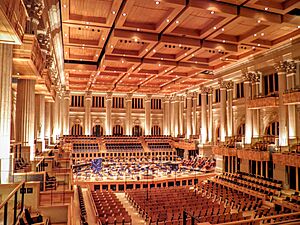
Adoniran Barbosa was a famous samba singer and songwriter. He was popular in the early days of radio in São Paulo. He was known for writing songs about the lives of city workers and the unemployed. His song "Trem das Onze" ("The 11 pm Train") is one of the best samba songs ever. It's about a man who has to catch the last train home to his mother. Another important musician with a similar style is Paulo Vanzolini.
In the late 1960s, a rock band called Os Mutantes became popular. They were part of the tropicalia music movement. They were known for their unique style. After the 1990s, Os Mutantes became famous outside Brazil.
In the early 1980s, the band Ultraje a Rigor (Elegant Outrage) started. They played a simple, fun style of rock. Their songs talked about changes in Brazilian society. A strong punk and garage music scene also grew in the 1980s. Bands like Ira! and Titãs came from this movement. In the 1990s, drum and bass music became popular. Many heavy metal bands also started in São Paulo, like Angra. The electro-pop band CSS is also from the city.
Many important Brazilian classical composers were born and live in São Paulo. The São Paulo State Symphony is one of the best orchestras in the world. In 1952, Heitor Villa-Lobos wrote a symphony for São Paulo's 400th anniversary.
São Paulo has several opera houses, like the São Paulo Municipal Theater. For symphonic concerts, there is the Sala São Paulo. The city also has many music halls, like Citibank Hall and Olympia. The Anhembi Sambadrome hosts music shows and the Carnival of São Paulo. The Virada Cultural (Cultural Overnight) festival happens once a year. It has hundreds of events all over the city.
Literature and Books
São Paulo was home to the first Jesuit missionaries in Brazil in the 1500s. They wrote reports about the new land and its people. They also wrote poetry and music to teach Christianity. These were the first written works from the area. Priests like Manuel da Nóbrega and José de Anchieta helped record the Old Tupi language.
In 1922, the Brazilian Modernist Movement began in São Paulo. This movement aimed for cultural independence. Brazilian writers started to create unique Brazilian works. The influence of former slaves added a special African touch to the culture. Later, immigrants from other countries brought even more influences.
Mário de Andrade and Oswald de Andrade were key Modernist writers. Mário de Andrade's poems about the city, "Paulicéia Desvairada" (1922), started the movement. His novel Macunaíma (1928) used Brazilian folklore to create a unique national hero. Oswald de Andrade's experimental writing broke away from old traditions.
Modernist artists and writers chose the Municipal Theatre of São Paulo to launch their ideas. They challenged the high society who preferred European culture.
Theaters and Performances
Many historians believe the first play in Brazil was in São Paulo. The Jesuit missionary José de Anchieta wrote short plays. These were performed for the Tupi–Guarani natives. In the late 1800s, a cultural and theater scene grew. European groups started putting on shows. The 1940s were a very important time for theater in São Paulo.
In the 1960s, two main groups presented plays. Teatro de Arena started with students from a drama school. Their play "Eles não usam black tie" was the first Brazilian play to feature workers as main characters.
After 1964, plays started focusing on Brazilian history. Teatro de Arena and Teatro Oficina supported democracy during the military dictatorship. This time was known for censorship. The Tropicalist movement also began here. Many plays showed important historical moments.
The Bixiga district has the most theaters, about 40. Some of the most important theaters are Renault, Bibi Ferreira, and Oficina.
Museums and Art Galleries
São Paulo has many historic neighborhoods and buildings. The city has a large number of museums and art galleries. Some famous museums include the São Paulo Museum of Art (MASP) and the Ipiranga Museum. It also has one of the top five zoos in the world, the São Paulo Zoo.
The Ipiranga Museum was the first monument built to remember Brazil's independence. It opened in 1895. In 1919, it became a history museum. Its collection has about 100,000 items, including art, furniture, and clothes. It also has a library with 100,000 books.
The Ema Gordon Klabin Cultural Foundation opened in 2007. It is in a 1920s mansion. It has 1,545 works of art, including paintings by Marc Chagall and Tarsila do Amaral.
The Memorial da América Latina (Latin America's Memorial) was created to show Latin American countries and their cultures. It has an exhibition hall, a library, and an auditorium. It was designed by Oscar Niemeyer.
The Hospedaria do Imigrante (Immigrant's Hostel) was built in 1886. It welcomed immigrants who arrived in Brazil. From 1882 to 1978, 2.5 million immigrants stayed there. In 1998, it became a museum. It keeps records and objects from the immigrants. The museum also has restored old train wagons.
The MASP has one of the world's most important collections of European art. It was founded by Assis Chateaubriand. Its building, opened in 1968, was designed by Lina Bo Bardi. MASP holds many temporary art exhibitions.
The Pinacoteca do Estado de São Paulo is next to the Luz metro station. It was designed in 1895. It became a museum in 1911. It hosts art exhibitions, like bronze statues by Auguste Rodin. It also has an exhibition about the "Resistance" movement during the military dictatorship.
The Catavento Museum is an interactive science museum. It opened in 2009. It has over 250 exhibits about the universe, life, engineering, and society. It is for young people.
The Oca is a white, spaceship-like building in Ibirapuera Park. It is an exhibition space. It shows modern art, Native Brazilian art, and photography.
The Museu da Imagem e do Som (Image and Sound Museum) keeps music, cinema, photography, and graphical arts. It has over 200,000 images. It also has many videos and films. The museum holds concerts, film festivals, and art exhibitions.
The Museu do Futebol (Football Museum) is at the famous Paulo Machado de Carvalho soccer stadium. It shows the history of soccer in Brazil. It has fun and interactive activities.
Media and News
São Paulo is home to Brazil's two most important daily newspapers: Folha de S.Paulo and O Estado de S. Paulo. The top three weekly news magazines, Veja, Época, and ISTOÉ, are also based here.
Two of Brazil's five major television networks, Band and RecordTV, are in São Paulo. SBT and RedeTV! are in Osasco, a nearby city. Globo, the most watched TV channel, has a big news and production center in São Paulo.
Many major radio stations are also in São Paulo. These include Jovem Pan, Rádio Mix, and BandNews FM. The phone area code for São Paulo is 11.
Sports and Recreation
São Paulo hosts important national and international sports events. The São Paulo Grand Prix for Formula One is held at the Interlagos Circuit. São Paulo has hosted the 1950 FIFA World Cup, the 2014 FIFA World Cup Opening Ceremony, and the 1963 Pan American Games. The city also has a Jockey Club for horse racing.
Like in the rest of Brazil, football (soccer) is the most popular sport. The city's main teams are Corinthians, Palmeiras, and São Paulo.
Formula One is also very popular. Famous Brazilian driver Ayrton Senna was from São Paulo. Four Brazilian drivers born in São Paulo have won the Brazilian Grand Prix. A new train station was built near the Interlagos circuit to make it easier to get there.
Other popular sports include volleyball, basketball, skateboarding, and tennis. São Paulo has many traditional sports clubs with teams in various championships. Important clubs include Esporte Clube Pinheiros and Clube Athletico Paulistano (basketball).
The São Silvestre Race happens every New Year's Eve. It started in 1925. The race distance is now 15 km (9.3 mi). The São Paulo Indy 300 was an IndyCar Series race held from 2010 to 2013.
In the Bom Retiro district, there is a public baseball stadium. The Núcleo de Alto Rendimento (NAR) is a high-performance sports center for Olympic athletes. São Paulo is also a strong place for rugby union in Brazil. The main rugby field is at the São Paulo Athletic Club, the city's oldest club.
The city has five major stadiums: Morumbi Stadium, Pacaembu Stadium, Allianz Parque, Canindé Stadium, and Arena Corinthians. It also has many gyms, tennis courts, and other sports arenas.
Images for kids
-
Public housing in Heliópolis.
See also
 In Spanish: São Paulo para niños
In Spanish: São Paulo para niños


